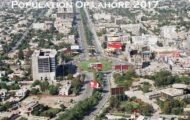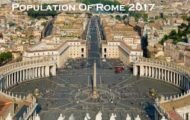Moscow also known a Russian federal city, is the capital and most populous city of the Russian Federation.
Moscow is a major political, economic, cultural, and scientific center of Russia and Eastern Europe, as well as the largest city entirely on the European continent.

Moscow is among the world’s largest cities, being the 14th largest metro area, the 18th largest agglomeration, the 15th largest urban area, and the 11th largest by population within city limits worldwide
According to Forbes 2013, Moscow has been ranked as the ninth most expensive city in the world by Mercer one of the fastest growing tourist destinations in the world.. Moscow is the northernmost and coldest megacity and metropolis on Earth.
The city has a rich transit network, with four international airports, nine railway terminals, numerous trams, a monorail system and one of the deepest underground rapid transit systems in the world. Moscow Metro, is recognized as one of the city’s landmarks due to the rich architecture of its 200 stations.
Moscow is among the world’s largest cities, being the 14th largest metro area, the 18th largest agglomeration, the 15th largest urban area, and the 11th largest by population within city limits worldwide. Moscow is run by one mayor, but the city is actually divided into 12 administrative okrugs and 123 districts, each with its own coat of arms and flags and individual heads of each area.
POPULATION OF MOSCOW IN 2017:
Talking about population, in order to check out the population of Moscow in 2017, we need to have a look at the population of the past 5 years. They are as per the following:
- 2012 – 11.92 million
- 2013 – 12 million
- 2014 – 12.1 million
- 2015 – 12.15 million
- 2016 – 12.19 million
MOSCOW Population 2017 – 12.3 million(Estimated)
Moscow is the capital city and most populous region in Russia. It’s also the second most populous city in Europe and the 11th largest city proper on earth. In 2016, the estimated population was 12.19 million.
At its last census in 2010, Moscow had a population of 11.5 million. In 2012, its territory expanded from 1,000 to 2,511 square kilometers, which added an additional 233,000 people. As Russia’s official figures are not believed to be completely accurate, the 2016 estimates put the population right under 13 million.
Population of Moscow with Moscow region is 17.3 million (according to 2010 census).
In the early 20th century Moscow was much smaller. The city started to grow very fast soon after the Revolution. In the first 10 years of Soviet Regime it had grown from 1 million up to 4 million people. Since 1917 Moscow population has increased almost 8 times.
Today Moscow is a multinational city. It attracts people from many neighboring countries. The most widespread nationalities in Moscow are Russians, Ukranians, Tatars, Armenians and Azerbajdjans. In Moscow you can see immigrants from all over the former Soviet Union.
Moscow’s population of about 12.19 million makes it the 6th largest city in the world and the most populous city in Russia. Moscow has a density of 8,537.2 people per square kilometer.
The City’s huge population is a sum of both permanent and temporary illegal migrants, plus the ongoing merging of suburbs, raise the unofficial population to about 13.5 million people – about one tenth of the entire Russian population. Even after this, Moscow continues to grow. This is largely due to its 20% per annum economic growth, which attracts workers (often illegally) from other parts of Russia where the economy has stagnated or is even in decline.
DEMOGRAPHICS OF MOSCOW:
According to the 2010 Census, the ethnic composition of Moscow was:- Russian: 91.6%, Ukranian: 1.42%, Tatar: 1.38%, Armenian: 0.98%, Jews: 0.49% and so on.
There was an additional 668,000 people registered in databases that could not declare an ethnicity.
The predominant religion is Christianity, with the Russian Orthodox Church being the most popular, also Muslims, meanwhile, account for 14% of the city’s population. Interestingly, Moscow also had the largest community of billionaires in the world in 2013. The country fell to the number three spot in 2016, trailing behind New York City and Hong Kong. The average monthly salary in the state is 61,200 roubles, which is almost double the nationwide average.
POPULATION DENSITY AND GROWTH RATE IN MOSCOW:
It’s hard to estimate exact population of Moscow is today, as the number of migrants (legal and illegal) has made it impossible to keep a precise track. While the official figure was 11.5 million as of 2010, this number could really be million in 2016
Death rates have been higher than birth rates in Moscow for years, and its growth is now solely dependent on migration. While Russia’s population is shrinking, more people continue to move to Moscow, which grew 10.9% from 2002 to 2010, while the country’s population decreased 1.2%.
Data says that legal and illegal immigrants in Moscow account for another 2-5 million, which may as well take the total number of city’s population to 15-17 million! The city has a high population density of 8,537.2 people/km2.
FACTS ABOUT MOSCOW:
• Moscow boasts the largest number of billionaires in the world. According to the Forbes, there are 84 billionaires in the city with the combined wealth of 367 billion dollars.
• Gorky Park is a Central Park of Moscow, with an attendance of more 100, 000 a day on the weekend.
•
• The city of Moscow was founded by Prince Yuri Dolgoruky in 1147. At that time the city was called Moskov, having more in common with its present English name Moscow.
• In old times, representatives of different social classes, professions and nationalities lived in Moscow separately. That’s how we got Chef and Butcher streets, as well as Georgian settlement and Maroseyka Street.
• Assumption Cathedral in the Kremlin is the oldest survived building in Moscow. The Moscow Kremlin is the world’s largest medieval fortress.
• “Moscow” meant “wet”, as Moscow was built on swamps.
• And there are 2700 restaurants in Moscow, and still counting.
Find Latest Moscow Population in 2018



